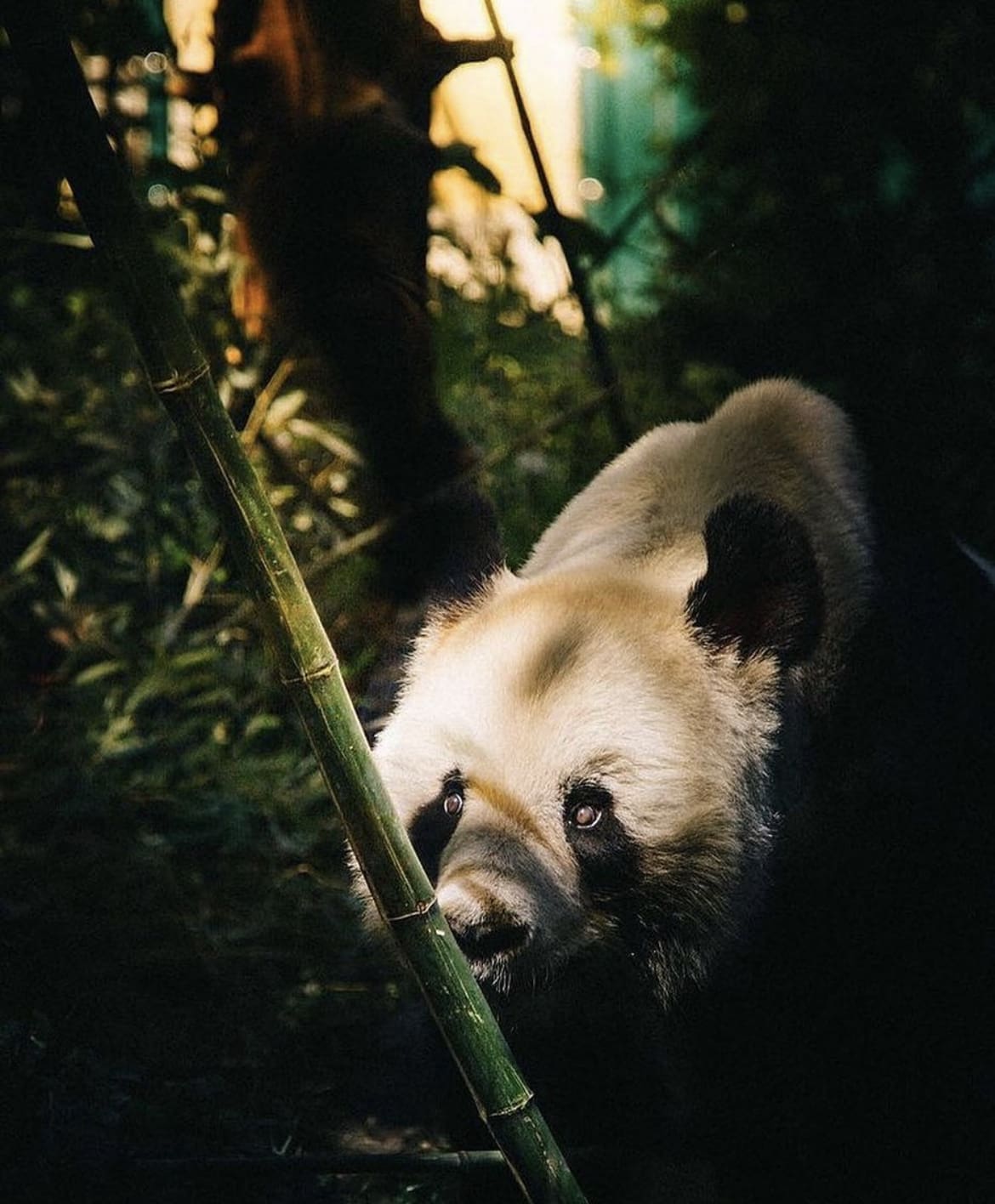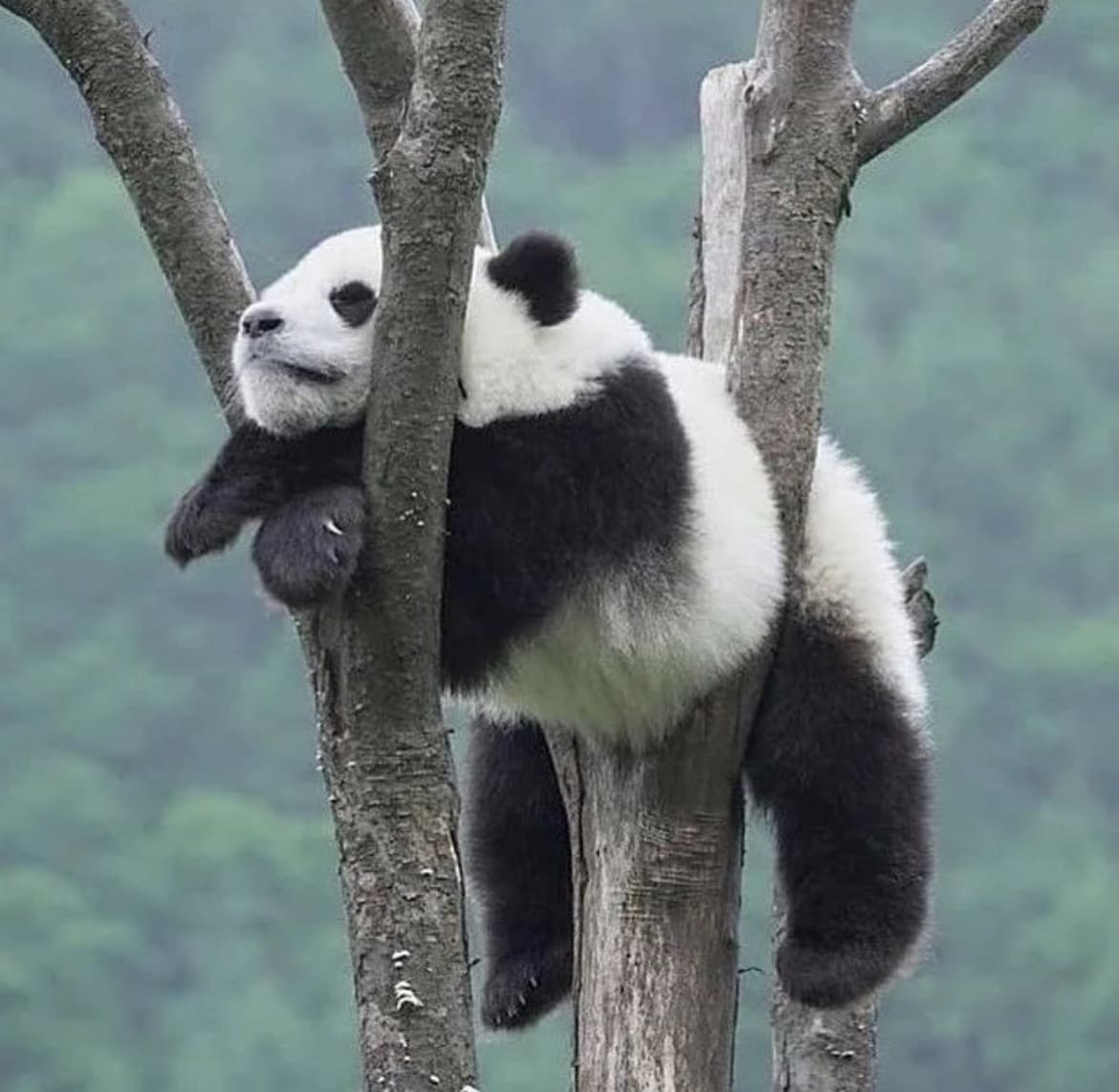Let’s dial up the charm with some insider scoop on one of nature’s most adorable and laid-back characters: the panda. Trust me, these creatures are more than just a cute face and a meme-worthy expression of chill.
They’re a fascinating blend of mystery, cuteness, and ecological significance wrapped in a black-and-white fur coat.
What is the Panda?
When we talk about pandas, the image that pops up in your mind is probably that of the giant panda (Ailuropoda melanoleuca), right? These guys are the rock stars of the conservation world, famously known for their cuddly appearance and the symbol of the World Wildlife Fund.
But let’s not forget about their lesser-known, yet equally adorable cousin, the red panda (Ailurus fulgens), who looks more like a mix between a raccoon and a bear and lives in the same cool, bamboo-filled forests. For the sake of this deep dive, though, we’re spotlighting the giant panda, a true emblem of wildlife conservation efforts and a national treasure of China.
Are Panda’s Bears?
Yes, pandas are bears. The giant panda (Ailuropoda melanoleuca) is a member of the bear family, Ursidae. Despite their distinctive black and white coloring and their primarily bamboo diet, which sets them apart from other bear species that have more omnivorous diets, genetic testing has confirmed that giant pandas share a closer evolutionary relationship with other bears. They are classified as a true bear species, alongside other members of the bear family such as the brown bear, black bear, polar bear, and others.
What do Pandas Look Like?
Imagine a bear that decided to go to a black and white themed party and nailed the dress code. That’s your giant panda. These creatures are unmistakable with their big, burly bodies, rounded faces, and big black patches around their eyes (talk about natural eye makeup goals), ears, and across their body.
They’ve got this unique look that sets them apart from any other bear species, making them the poster children of the animal conservation world. And let’s be real, who hasn’t been mesmerized by those soulful eyes peering out from a sea of fluffy fur?
How Big are Pandas?
On to the stats! Adult giant pandas are pretty hefty, tipping the scales at up to 250 pounds (113 kilograms) for males, while the ladies are a bit lighter, usually around 220 pounds (100 kilograms).
They’re not the tallest creatures in the forest, standing about 2 to 3 feet (60 to 90 centimeters) tall at the shoulder on all fours, but when they stand up on their hind legs, they can reach up to 6 feet (1.8 meters) tall. Just think about bumping into that during a midnight snack run in the forests of Sichuan.
Their size plays a crucial role in their laid-back lifestyle, as it allows them to store fat and conserve energy, which is pretty handy considering their diet. But more on that in a bit.

Panda Fur
Ever wondered what makes panda fur so special? Apart from making them look absolutely huggable, their fur is a marvel of nature designed to keep them comfortable in the cool, misty mountain ranges they call home.
Panda fur is thick, woolly, and longer than you might expect, offering superb insulation against the cold. This coat isn’t just for warmth, though; it’s also a great camouflage tool, blending in with the snowy and rocky backgrounds of their habitat.
Panda Colouration
Now, onto the black and white of it. The panda’s iconic coloration has been the subject of much speculation. Why do they look like they’re ready for a black-tie gala in the middle of the forest?
Some theories suggest their distinct patches help them stand out in the dense forests to find each other for mating. Others believe the contrasting colors provide camouflage in their natural habitat, with the white blending in with the snow and the black with the shadows of the forest.
But let’s be real, whatever the reason, their unique look has captured hearts worldwide, making them one of the most recognizable animals on the planet.
What do Pandas Eat?
If you thought pandas spent their days lazing around with an occasional snack, think again. These creatures are eating machines, munching on bamboo for up to 12 hours a day. That’s right, bamboo—a plant so tough and fibrous, it’s more work than it’s worth for most animals. But pandas have developed a taste for it, and it makes up more than 99% of their diet.
They’ve got this special wrist bone that’s evolved into a pseudo-thumb, helping them hold onto bamboo stalks while they strip them with their teeth. And they need to eat a lot of it, between 26 to 84 pounds (12 to 38 kilograms) daily, because bamboo isn’t exactly high in nutrients. Talk about a high-fiber diet!
Pandas do occasionally branch out, gastronomically speaking. They’ll eat other vegetation and even meat in the form of birds, rodents, or carrion if they stumble upon it. But bamboo is their bread and butter—or should we say, their stalk and leaf. This diet has shaped much of their lifestyle, habitat preference, and even their reproductive strategy.
Panda Social Structure
Pandas are actually quite the introverts. They lead mostly solitary lives, with adults only really coming together for brief periods during the mating season. Their social structure is all about personal space—each panda has its own territory, which they mark with scent to communicate with other pandas.
These scents convey messages like “I’m ready to mate,” or “Back off, this bamboo buffet is mine!” It’s like panda social media, but with smells instead of selfies.
How do Pandas Reproduce?
When it comes to making more pandas, these creatures take the “less is more” approach. Female pandas are only fertile for about 2-3 days each year, which doesn’t leave much window for baby-making. When they do mate, the gestation period can vary widely, from 95 to 160 days, because of a phenomenon called delayed implantation. This means the fertilized egg doesn’t immediately implant in the uterus, allowing the mother to time the birth with favorable environmental conditions.
The result? Usually a single cub, though twins aren’t unheard of. These cubs are incredibly tiny at birth—about the size of a stick of butter compared to their large mothers. Cubs are helpless and rely entirely on their mother’s warmth, milk, and protection to survive their first few months. This slow reproduction rate, combined with habitat loss, has made panda conservation a critical task.
How Long do Pandas Live?
In the wild, pandas can live to be around 20 years old, but life in the bamboo forest isn’t always easy. Predators aren’t a significant concern thanks to their size, but habitat destruction and fragmentation pose real threats to their survival and longevity. In captivity, where threats are minimized, and healthcare is readily available, pandas have been known to live well into their 30s. The record holder for the oldest panda lived to a ripe old age of 38. This longer lifespan in captivity helps researchers and conservationists learn more about pandas and how to protect them, contributing valuable information towards their preservation in the wild.
Pandas’ lives are a delicate balance of eating, mating, and roaming their territories. Their solitary nature, unique reproductive challenges, and the specific demands of their diet all play into the broader narrative of conservation. The efforts to protect these iconic creatures and their habitats are as much about preserving the natural world as they are about saving an international symbol of wildlife conservation.
Are Pandas Aggressive?
Pandas, with their chubby cheeks and seemingly gentle demeanor, might look like they wouldn’t hurt a fly. And for the most part, you’d be right. They’re generally peaceful creatures, preferring to munch on bamboo rather than pick a fight. However, like any wild animal, pandas can be aggressive if they feel threatened or if their space is invaded.
Mother pandas are especially protective of their cubs and can display surprising ferocity if they perceive danger. So, while they may appear as docile as a plush toy, it’s essential to remember that pandas are still bears with the strength and instincts to match. The takeaway? Admire from a distance and respect their wild nature.
Are Pandas Territorial?
Despite their solitary nature, pandas do have a system when it comes to their space. They’re not territorial in the aggressive, keep-out-at-all-costs way some animals are, but they do have home ranges that they prefer to stick to.
These ranges can overlap, particularly in areas where bamboo is abundant, and they seem to have a mutual understanding about sharing resources. They communicate through scent marking, leaving behind messages in their paths for other pandas to find.
This way, they can avoid unnecessary confrontations and live relatively harmonious lives, each in their own bamboo-filled bubble.
Where do Pandas Live?
The natural habitat of the giant panda is among the most stunning on the planet, nestled within the misty mountains of central China. These areas, such as Sichuan, Shaanxi, and Gansu provinces, offer the cool, humid climate that pandas love and the bamboo forests they depend on for food. The terrain is rugged, with dense montane forests that provide not just food but also the seclusion pandas prefer.
Unfortunately, these specific conditions mean that pandas have a very limited natural habitat, which is under constant threat from human encroachment. Conservation areas and nature reserves have been established to protect these environments, but the balance is delicate, and the effort to keep pandas safe in their natural homes is ongoing.
The habitat of the panda is as unique as the creature itself, requiring careful management and protection to ensure these animals have a future in the wild. The challenges they face from habitat loss underscore the importance of conservation work, not just for pandas but for the entire ecosystem they inhabit.
How Many Pandas are There in the Wild?
The story of the panda’s journey from the brink of extinction is one of cautious optimism. For decades, the number of giant pandas in the wild was dangerously low, mainly due to habitat destruction and fragmentation. However, thanks to concerted global and local conservation efforts, their numbers have been slowly but steadily climbing. As of the latest estimates, there are now over 1,800 pandas living in the wild and in captivity. This remarkable turnaround is a testament to what can be achieved with dedication and cooperation in conservation efforts. The Chinese government, along with international organizations, has worked tirelessly to expand and protect panda habitats and establish breeding programs to increase their numbers. While the giant panda is still considered vulnerable, its removal from the endangered species list in 2016 marks a significant victory for wildlife conservation.

Are Pandas Endangered?
Despite the positive trends in panda conservation, the giant panda remains classified as vulnerable. The primary threats to their survival haven’t disappeared; habitat loss, fragmentation, and climate change continue to pose significant risks to their natural environments.
The bamboo forests they rely on for food are particularly vulnerable to these threats. While the increase in panda numbers is encouraging, it also underscores the importance of continued vigilance and effort in conservation. Protecting the panda’s habitat, along with climate action, are critical components of ensuring their survival.
The story of the panda reminds us that conservation is an ongoing battle, not a victory to be declared once and forgotten.
Threats to Pandas in the Wild
The main threats to pandas in the wild are as insidious as they are persistent. Habitat destruction, due to agricultural expansion, logging, and development, has fragmented the forests pandas need not just to live, but to migrate in search of food.
Bamboo, their primary food source, has a unique flowering cycle that can leave pandas vulnerable to starvation if they cannot move to new areas. Climate change exacerbates these challenges, altering the delicate balance of their mountainous habitats and affecting bamboo growth. Poaching, though less of a threat today thanks to strict protections, has also contributed to their precarious position in the past.
The fight to protect pandas involves not only safeguarding their current habitats but also restoring and connecting fragmented forests to ensure pandas have the space and resources they need to thrive.
The conservation of the giant panda is a complex issue that involves habitat protection, anti-poaching efforts, and addressing the broader implications of climate change.
 Where to See Pandas on Safari
Where to See Pandas on Safari
Dreaming of seeing pandas in their natural habitat? Your best bet is visiting one of the several panda reserves in China, where these creatures roam relatively freely within vast, protected areas. The Wolong National Nature Reserve, Chengdu Research Base of Giant Panda Breeding, and the Qinling Panda Sanctuary are among the top spots where visitors can witness pandas living their best lives amidst lush bamboo forests. These reserves not only offer a chance to see pandas up close but also play critical roles in research, conservation, and education efforts aimed at preserving giant pandas and their habitats. Visiting these places, you’re not just ticking off a bucket list item; you’re also supporting conservation efforts that help keep pandas thriving in the wild.
Tips for Spotting Pandas
Spotting a panda in the wild is an unforgettable experience, but it requires a bit of know-how and a lot of patience. Here are some tips to increase your chances of a panda encounter:
- Go with a Guide: Local experts know the best spots and times for panda sightings and can lead you safely through their habitats.
- Visit in the Morning or Late Afternoon: Pandas are most active during these cooler parts of the day, munching on bamboo or playing.
- Keep Quiet and Keep Your Distance: Pandas are shy creatures, and keeping a low profile helps avoid spooking them.
- Respect Their Home: Stick to marked paths and follow reserve rules to minimize your impact on panda habitats and their wild neighbors.
Facts about The Panda
Let’s wrap up with some panda facts that highlight just how special these creatures are:
- Pandas have a “thumb”: Technically a modified wrist bone, this “thumb” helps pandas grip bamboo stalks while eating.
- They’re bamboo connoisseurs: Pandas can eat over 20 different species of bamboo but will usually favor just a few, depending on what’s available.
- Big babies: Panda cubs are born weighing just about 3.5 ounces (100 grams), making them one of the smallest mammal newborns relative to their mother’s size.
- Cultural icons: Beyond their ecological role, pandas have a significant cultural impact, symbolizing peace and friendship, especially in Chinese culture.
Myths about The Panda
Finally, let’s clear up some common myths about pandas:
- Myth: Pandas are lazy. Truth: Pandas’ bamboo diet is low in calories, so they conserve energy by moving less, not out of laziness but necessity.
- Myth: Pandas only live in China. Truth: While wild pandas are only found in China today, fossil records show they once roamed throughout Asia.
- Myth: Pandas are poor breeders. Truth: While breeding pandas in captivity was challenging, improvements in understanding their needs have led to significant success in recent years.
Pandas, with their distinctive charm and unique lifestyle, continue to fascinate and inspire conservation efforts around the world. By supporting these efforts and spreading awareness, we can ensure that future generations will also have the opportunity to get to know these incredible animals.
Whether through a visit to a reserve, adopting a panda from afar, or simply sharing their story, every action counts towards the conservation of the giant panda and the rich ecosystems they inhabit.





 Where to See Pandas on Safari
Where to See Pandas on Safari